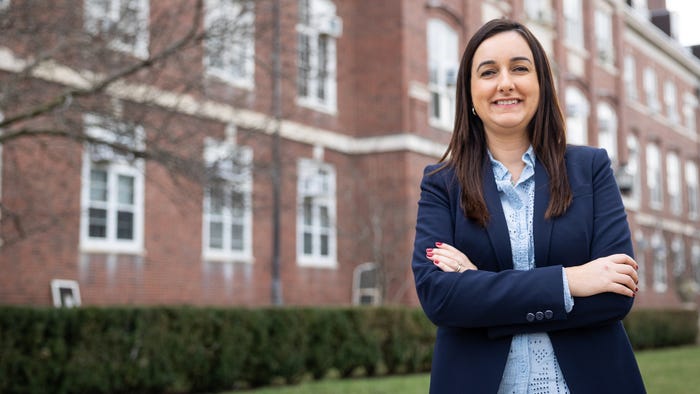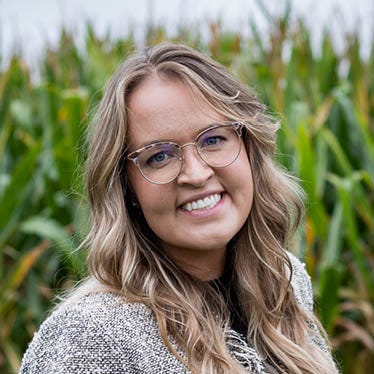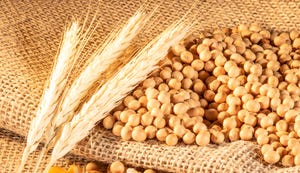March 16, 2023

GLOBAL AGRIBUSINESS: Joana Colussi is best recognized for her contributions to the University of Illinois Farmdoc team on South American agriculture. She says that in today’s global market, it’s crucial to examine how weather events and increased production in other parts of the world will impact the commodity market.Betty Haynes
Moving to a different country and changing careers would be out of the question for most, but not for Joana Colussi, who says that in all challenges, there are opportunities to learn.
Today, Colussi is best recognized for her contributions to the University of Illinois Farmdoc team on all things relating to South American agriculture. But her road to U of I was far from ordinary.
“It’s important for Americans to understand that everything that happens in Brazil and Argentina will directly impact the American market,” Colussi says. ��“Because today’s agriculture is a very global industry, we have to closely watch South American weather patterns and production.”
Colussi was raised in São José do Herval, a small town in southern Brazil. Curious by nature, Colussi pursued a career in journalism so she could travel, meet new people and learn something new every day.
She worked as a reporter, first for Correio do Povo and Zero Hora newspapers, and then for Globo Rural magazine, covering Brazilian agriculture for over a decade until getting the itch to learn more. Colussi decided to get a master’s degree, studying agribusiness, and a doctorate, studying agribusiness technology and innovation, while continuing to work as a reporter.
“At the end of my master interview, one of the professors, Homero Dewes, told me that attending university would create a personal or professional crisis for me,” Colussi explains. “And if I was willing to face the crisis head on, it would open a new world for me. He was right.”
Soon Colussi was burning the candle at both ends, balancing her reporting work and doctoral studies. It was time for a change.
“Sometimes when we’re waiting for something new, we need to leave what we have,” Colussi says. “I felt like life was telling me to have the courage to leave my job and have a different experience as a researcher.”
Colussi emailed Professor Emeritus Steve Sonka at the University of Illinois about continuing her studies in the United States. He mentored her, connecting her with Professor Gary Schnitkey, who would later become Colussi’s advisor, and in January 2020, she moved to Champaign, Ill. Just a few weeks later, the COVID-19 pandemic put the world in a standstill.
“It was a dream of mine to live in the U.S., but the pandemic and I arrived here at nearly the same time,” Colussi recalls. “I faced the pandemic alone, away from my family and my now husband. It was a challenging time but, in all challenges, there are opportunities.”
At the end of 2020, Colussi told Schnitkey that her year of study was short of what she had in mind. Schnitkey offered her the chance to stay at the U of I and work with the Farmdoc team.
“When I started at Farmdoc, it was difficult because I’m not an economist,” Colussi says. “But I realized that as a journalist, I have a lot of tools that would serve me well and set me apart – like writing, communicating and recording videos.”
Today, Colussi’s official title is postdoctoral research associate at the University of Illinois, half in research and half in Extension with the Farmdoc team. But her journey is far from over. This fall, Colussi will teach her first class at the U of I — Global Agribusiness Management — where her title will change to instructor.
She took some time away from Mumford Hall on the U of I campus to talk with Prairie Farmer.
How are Brazilian farmers and American farmers similar? When you look inside the farms in Brazil, the farmers use the same technology that farmers use here — the same machines, the same seeds and the same chemicals. Yields are also very similar, especially in soybeans. Brazil is the No. 1 export country for soybeans, and the No. 1 world leader in total soybean production. The U.S. is the No. 2 export country for soybeans and No. 2 in total soybean production. Brazil’s corn yields are usually lower since corn is typically planted as a second crop, in a period of high climatic risk.
Corn as a second crop? In Brazil, farmers don’t need to choose between corn and soybeans; they can have both. Since Brazil is a tropical country, there is the safrinha, or the second corn crop. In the first crop, farmers in the center-west area of Brazil normally plant soybeans and harvest in February or March. In the same day that they harvest soybeans, they’ll plant corn. Most of the second or third crop in Brazil is corn, so corn yield averages tend to be much lower than in the United States.
How are Brazilian farmers and American farmers different? The average age of a farmer in Brazil is about 10 years younger than in the United States. Farms are generally larger, with 5,000- or 10,000-acre farms very common, and some big companies farming over a million acres. Another big difference is infrastructure. The cost of transporting goods is higher in Brazil because of their dependence on trucks, rather than barge or rail systems. It’s also pretty unique for farmers in Brazil to have on-farm grain storage and reliable internet in the new agriculture frontiers.
And cattle production? In Brazil, about 90% of cattle are grass-fed and raised on pasture, instead of in feedlots or confinement barns. In many regions, it’s too hot for breeds like Angus, so many Brazilian vaqueros raise heat-tolerant breeds like Nelore. Brazil is the No. 1 export country for beef, but the U.S. is No. 1 in total beef production. The U.S. is the No. 2 export country for beef, with Brazil No. 2 in production.
What are farmers most surprised to learn about Brazil? It’s difficult to explain how Brazil can increase acres in production each year. Brazil has new agriculture frontiers in many regions, especially in the center-west and northeast regions. Every year Brazil has new land in these regions being converted for production agriculture use. Acreage increases of 5% or 10% each year over the last 20 years are challenging for most American producers to understand.
What is your advice to the next generation? Don’t be afraid to change. Sometimes what life wants from you is courage.
What do you want your legacy to be? To inspire others, promote change and help people.
What is the most important decision you have made? To move to the U.S.
What is the quality you admire most in a person? Honesty and humility.
Which living person do you most admire? My father because of the challenges he was able to overcome in his lifetime.
What is your most treasured possession? My reputation.
What motivates you? To improve personally and professionally.
Where is your favorite spot in the world? My parents’ house in Brazil, having barbecue and watching a soccer game.
How do you spend your free time? I love music, so I enjoy attending live concerts, festivals and fairs.
Which words or phrases do you most overuse? Never give up.
What’s the best piece of advice you’ve ever received? Listen to your heart because your intuition is usually right.
What’s your guilty pleasure? Drinking Coca-Cola and eating carbs like pasta, bread and polenta.
Who is your favorite musical artist or band? I like pop and country music. In Brazil, my favorite artist is Michel Teló. In the U.S., my favorite artist is Luke Bryan.
If your mother wrote a book about you, what would it be called? “See the Bright Side of Things.”
How have you known when it was time to make a change in your life? If I’m unhappy or impatient.
Colussi in brief
Crop? Soybeans
Livestock? Beef cattle
Technology? Smartphone
Team? Brazilian soccer team Internacional from Porto Alegre
Book? “Thinking Fast and Slow” by Daniel Kahneman
Food? Brazilian barbecued picanha or in the U.S., ribeye or T-bone
Family? Husband, Fernando; parents, João and Terezinha; brother, Jones
Brazilian ag in brief
No. 1 producer: Soybeans, sugar, orange juice, coffee
No. 1 exporter: Soybeans, beef, chicken, orange juice, sugar cane, coffee
No. 2 exporter: Corn, cotton, ethanol from sugar cane
No. 4 exporter: Pork
Average price of land: $4,049 per acre
Average land price in Paraná (similar to Illinois): $8,097 per acre
Average soybean and corn farm size: 1,300 acres
Average farmer age: 47
Average soybean yield: 52 bushels per acre
Average corn yield: 90 bushels per acre
About the Author(s)
You May Also Like






